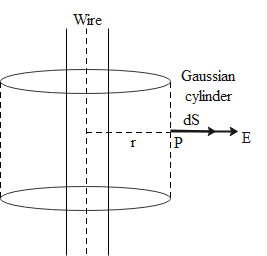
Electric field outside a long wire carrying charge q is proportional to:
$
{\text{A}}{\text{. }}\dfrac{1}{r} \\
{\text{B}}{\text{. }}\dfrac{1}{{{r^2}}} \\
{\text{C}}{\text{. }}\dfrac{1}{{{r^{\dfrac{1}{{3/5}}}}}} \\
{\text{D}}{\text{. }}\dfrac{1}{{{r^{\dfrac{1}{{3/2}}}}}} \\
$
Answer
546.6k+ views
Hint: We need to use the Gauss law to obtain the expression for the electric field outside a long wire carrying a charge q. From the obtained expression, we can check the dependence of the electric field on distance r from the wire which will give us the required answer.
Formula used:
Gauss law is given as
$\oint {\overrightarrow E .\overrightarrow {dS} = \dfrac{{{q_{net}}}}{{{ \in _0}}}} $
Complete answer:
We are given a long cylindrical wire as shown in the following diagram.

It carries a total charge q and the amount of charge per unit length of the wire can be written as
$
\lambda = \dfrac{q}{l} \\
q = \lambda l \\
$
Here l signifies the length of the wire. Now consider a point P outside this wire at distance r where we want to calculate the electric field due to the wire. Since we are going to use the Gauss law for this, we also need to construct a Gaussian surface around it.
For a cylindrical wire the Gaussian surface will look like a cylinder whose radius is r. Now we can apply the Gauss law to this cylinder in the following way.
$\oint {\overrightarrow E .\overrightarrow {dS} = \dfrac{{{q_{net}}}}{{{ \in _0}}}} $
Here dS is the small area element on the Gaussian cylinder. We can solve this in the following way.
$
E\int {dS} = \dfrac{q}{{{ \in _0}}} = \dfrac{{\lambda l}}{{{ \in _0}}} \\
\Rightarrow E \times 2\pi rl = \dfrac{{\lambda l}}{{{ \in _0}}} \\
\therefore E = \dfrac{\lambda }{{2\pi { \in _0}r}} \\
$
This is the final expression for the electric field due to the wire at a distance r outside it. We see that $E \propto \dfrac{1}{r}$.
Therefore, the correct dependence of E on distance is option A.
Note:
It should be noted that the direction of the electric field and the area element is the same. Due to this, $\overrightarrow E .\overrightarrow {dS} = EdS\cos 0^\circ = EdS$. Also, the electric field due to the wire is constant since the charge on the wire is also constant, so we have taken E out of the integral in the above calculation.
Formula used:
Gauss law is given as
$\oint {\overrightarrow E .\overrightarrow {dS} = \dfrac{{{q_{net}}}}{{{ \in _0}}}} $
Complete answer:
We are given a long cylindrical wire as shown in the following diagram.

It carries a total charge q and the amount of charge per unit length of the wire can be written as
$
\lambda = \dfrac{q}{l} \\
q = \lambda l \\
$
Here l signifies the length of the wire. Now consider a point P outside this wire at distance r where we want to calculate the electric field due to the wire. Since we are going to use the Gauss law for this, we also need to construct a Gaussian surface around it.
For a cylindrical wire the Gaussian surface will look like a cylinder whose radius is r. Now we can apply the Gauss law to this cylinder in the following way.
$\oint {\overrightarrow E .\overrightarrow {dS} = \dfrac{{{q_{net}}}}{{{ \in _0}}}} $
Here dS is the small area element on the Gaussian cylinder. We can solve this in the following way.
$
E\int {dS} = \dfrac{q}{{{ \in _0}}} = \dfrac{{\lambda l}}{{{ \in _0}}} \\
\Rightarrow E \times 2\pi rl = \dfrac{{\lambda l}}{{{ \in _0}}} \\
\therefore E = \dfrac{\lambda }{{2\pi { \in _0}r}} \\
$
This is the final expression for the electric field due to the wire at a distance r outside it. We see that $E \propto \dfrac{1}{r}$.
Therefore, the correct dependence of E on distance is option A.
Note:
It should be noted that the direction of the electric field and the area element is the same. Due to this, $\overrightarrow E .\overrightarrow {dS} = EdS\cos 0^\circ = EdS$. Also, the electric field due to the wire is constant since the charge on the wire is also constant, so we have taken E out of the integral in the above calculation.
Recently Updated Pages
Master Class 12 Business Studies: Engaging Questions & Answers for Success

Master Class 12 Economics: Engaging Questions & Answers for Success

Master Class 12 English: Engaging Questions & Answers for Success

Master Class 12 Maths: Engaging Questions & Answers for Success

Master Class 12 Social Science: Engaging Questions & Answers for Success

Master Class 12 Chemistry: Engaging Questions & Answers for Success

Trending doubts
What are the major means of transport Explain each class 12 social science CBSE

Which are the Top 10 Largest Countries of the World?

Draw a labelled sketch of the human eye class 12 physics CBSE

Explain sex determination in humans with line diag class 12 biology CBSE

The pH of the pancreatic juice is A 64 B 86 C 120 D class 12 biology CBSE

Give 10 examples of unisexual and bisexual flowers




